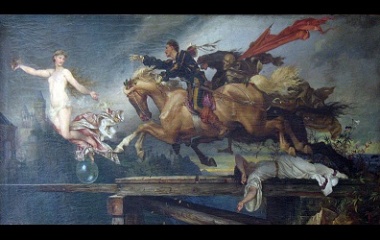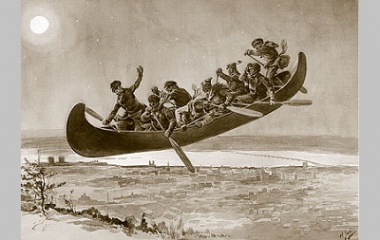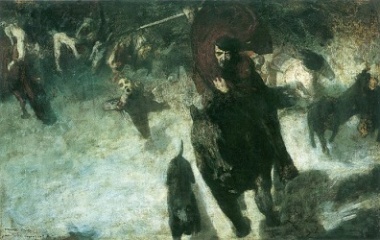You don’t want to be outside when the ghostly procession of the Wild Hunt surges passed. You may be sucked into their dark frenzy, with or without your body along for the ride!
What Is the Wild Hunt?
Across Central, Western and Northern Europe, the Wild Hunt is a well-known folk myth of a ghostly leader and his group of hunters and hounds flying through the cold night sky, accompanied by the sounds of the howling wind. The supernatural hunters are recounted as either the dead, elves, or in some instances, fairies. In the Northern tradition, the Wild Hunt was synonymous with great winter storms or changes of season.
Source
The Anglo-Saxon Chronicles, one of the oldest sources of Anglo-Saxon history, first mention the Wild Hunt in 1127 AD. In 1673, Johannes Scheffer, in his book Lapponia, recounts stories by the Laplanders or Sami people of the Wild Hunt. Author Hélène Adeline Guerber wrote of Odin and his steed, Sleipnir, in her 1895 works, Myths of the Northern Lands. She tells her readers of the souls of the dead being carried off on the stormy winds of the hunt.
The concept was popularized by author and mythologist Jacob Grimm in 1835 in his works Deutsche Mythologie. In his version of the story he mixed folklore with textual evidence from the Medieval up to the Early Modern period. Many criticized his methods, which emphasized the dynamic nature of folklore. He believed the myth to have pre-Christian roots and its leader to allegedly be based on the legends of Odin, on the darker side of his character. He also thought the leader of the hunt may have been a woman, perhaps a heathen goddess named Berchta or Holda. He believed the female may also have been Odin’s wife.
The Legend
The hunt was said to pass through the forests in the coldest, stormiest time of the year. Anyone found outdoors at the time would be swept up into the hunting party involuntarily and dropped miles from their original location. Practitioners of magic may have sought to join the berserkers in spirit, while their bodies remained safely at home. Grimm postulated the story inevitably changed from pre-Christian to more modern times. The myth originally began as a hunt led by a god and goddess visiting the land during a holy holiday, bringing blessings, and accepting offerings from people. They could be heard by the people in the howling winds, but later became known as a pack of ghouls with malicious intent.
The Leader of the Hunt
The numerous variations of the legend mention different leaders of the hunting party. In Germany the leader is known by various names, for instance, Holt, Holle, Berta, Foste or Heme. Yet one figure frequently appears in the majority of versions: Odin (also called Woden). Odin is known by two particular names which relate to the time of year the Wild Hunt was alleged to occur, Jólnir and Jauloherra. Both of these roughly mean Master of Yule, a festival celebrating the change of the seasons.
The legend of the hunt has been adapted over the years and, depending also on the geographical location, the leader of the hunt along with it. In the middle ages, with heathen deities becoming a thing of the past, the hero of the story became characters such as: Charlemagne, King Arthur or Frederick Barbarossa (the Holy Roman Emperor in the 12th century).
In the 16th century, Hans von Hackelnberg was said to lead the Wild Hunt. The story recounts him slaying a boar, accidently piercing his foot on the boar’s tusk and poisoning himself. The wound was fatal and, upon his death, von Hackelnberg declared he didn’t want to go to heaven, but instead continue with his treasured avocation – hunting. He was then forced to do this for an eternity in the night sky, or, as recounted in alternate versions, condemned to lead the Wild Hunt. Sources cite his name as possibly being a corruption of an epithet of Odin’s name.
In Wales, a variation of the story exists purporting the leader to be Gwynn ap Nudd or Lord of the Dead. In this version, the Lord of the Dead is followed by a pack of hounds with blood-red ears. In England, the same white hounds with red ears appear in legends. They were called the Gabriel hounds and said to portend doom if you saw them. Herne the Hunter, or Herlathing, is alleged to be the hunt’s leader in Southern England and possibly connected to the mythical king Herla. The Orkney Island tradition speaks of fairies or ghosts coming out at night and galloping on white horses. In Northern France, Mesnée d’Hellequin, the Goddess of Death, was said to lead the ghostly procession.
Regional Versions
Clerics in 12th century Britain reportedly witnessed the Wild Hunt. They claimed there were 20 to 30 hunters in the party and the hunt continued for nine weeks. The earlier reports available of the Wild Hunt generally represented the participants as diabolical, whereas, in later medieval retellings, the hunters became fairies instead. The legend’s origin, some believe, may be related to the Dandy Dogs. In the tale, Dando wanted a drink of water, cursed his huntsman for not having any and was then offered water by a stranger. The stranger stole Dando’s game and Dando himself, causing his dogs to give chase. Another version focuses on King Herla who had just visited the Fairy King. The king was told not to dismount his horse until the greyhound he carried had jumped down first. Three centuries passed and his men continued to ride as the dog had not jumped down yet.
In Germany, the hunter is sometimes associated with a devil or dragon and rides a horse, accompanied by numerous hounds. The prey, if mentioned, is usually a young woman who is either innocent, or guilty of some crime. Often the tail recounts someone encountering the hunt. If they oppose or stand up to the evil horde they are punished, but if they aid the hunters they are rewarded, customarily with money or the leg of a slain animal. Unfortunately, if they receive the latter, it is usually cursed and impossible to get rid of without the aid of a magician or priest. The tales also mention that someone standing in the middle of the road is somehow safe from the hunting procession.
The Wild Hunt was not seen – only heard – in Scandinavian versions of the myth. Typically the barking of Odin’s dogs, as well as the forest growing deathly silent, warned people of their imminent arrival. The hunt commonly signified a change in seasons or the onset of war in their folklore.
In Scotland, the Wild Hunt is closely linked to the fairy world in some sources. Evil fairies, or fey, were said to be cast from the Sluagh or Unseelie Court, the noble fairy court. The Sluagh allegedly flew in from the west in order to capture dying souls, resulting in people in Scotland, up until the 20th century even, closing windows and doors on the west side of their houses when they had a sick person inside! Similarly, The Orkney Islands were said to be home to trows, or trolls. The creatures supposedly hated the sunlight and tried to catch and eat mortals, unless the humans were lucky enough to escape by crossing over a stream!
In Modern Paganism
In modern Pagan tradition, practitioners incorporate the concept of the Wild Hunt in their rituals. In the late 1990s, anthropologist Susan Greenwood witnessed such a ritual. She reported the Pagans used the myth in order to lose themselves, as well as confront and restore harmony with the wild, dark side of nature. According to the Handbook of Contemporary Paganism, the hunt embraces the participation with souls, the dead and animals, as well as the ritualized circle of life and death.
Folklore sought to bring understanding to what was unexplainable at the time, often through the personification of concepts. In today’s world, we have science and technology to demystify any concepts which haven’t been categorized, cataloged, or clarified. Thankfully, we have not unlocked every puzzle in the universe yet, and with recent technological advancements, may yet go where no man has gone before!










